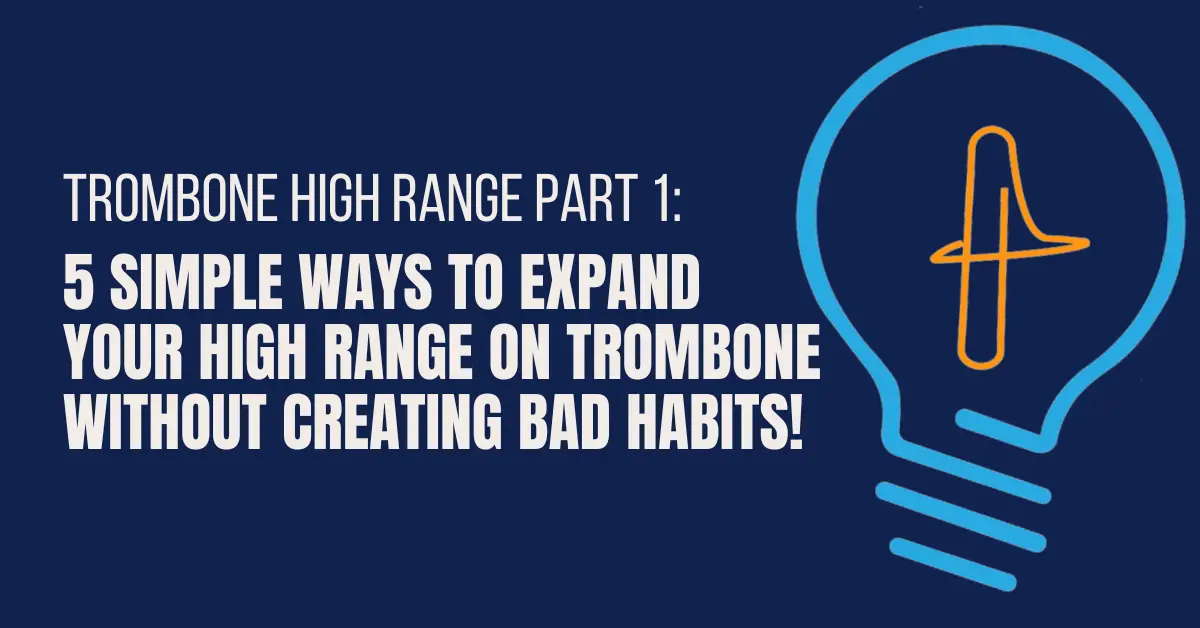Early in my career, playing high notes was a struggle. I spent a lot of time and effort developing my high range. I did things the wrong way at first and created bad habits I had to correct later. Over time, I discovered many drills that helped me develop a reliable, consistent, and accurate high range with tension-free technique.
I want to help you avoid the mistakes I made by showing you my favorite Beginner High Range Drills. These drills are essential to developing the high range you need, and if you’re struggling to find your way or feeling frustrated and overwhelmed, these drills will provide a proven path to success that is easy to begin.
Introducing the Upper Register of the Trombone
Success in the high range requires
- Confidence
- Consistency
- Strength
- Endurance
- Accuracy
- Tension-free technique
- And a beautiful tone
The following drills will help you develop the elements above by providing a simple approach to begin expanding your high range and avoid developing bad habits.
These drills start with notes you can play easily and help you stay motivated as you practice playing high notes the RIGHT WAY!
In this guide, you’ll learn to
- Expand your high range with ease and beautiful tone using simple drills that develop tension-free technique
- Build strength and endurance using notes you can already play easily
- Play high notes with confidence by using a patient approach that delivers accuracy, consistency, and immediate feedback
Here’s what’s inside:
- The Chromatic Scale
- The 7:1 Gliss
- Horizontal Slurs (Fretting and Tongueless Scales)
- The 10-Note Scale
- Melodies and Music
Before we dig into the drills, let me mention a few essential details.
Setting the Stage
There are no shortcuts to building a reliable high range on trombone. It is a long process that demands consistent effort and the proper mindset.
I do my best work when I remind myself to
- Commit to practicing every day
- So I‘m always making progress
- Set small, specific goals
- Like just playing my target note once with at least decent tone
- Keep my expectations low
- By expecting failure and frustration
- Give myself permission to fail
- So I dare to experiment with new ideas
- Give myself grace when frustration sets in
- To keep me motivated to show up tomorrow and try again
- Be grateful for the opportunity to practice and improve every day
- So I don’t get too wrapped up in my head when I fail
This mindset doesn’t eliminate frustration or suggest I won’t have setbacks. Still, it does provide a solid foundation for dealing with adversity by helping me keep things in perspective.
I remind myself often that what I do is far more important than how I do it.
Mostly, I strive not to overthink it! I just commit to showing up every day and trust my effort will eventually produce the outcomes I seek. I don’t have to achieve my ultimate goal today. I just have to progress toward it.
A Brief Thought on Tone Quality
Playing with a beautiful tone is everything!
If I don’t play with a beautiful tone, no one will want to listen to anything I play. It’s that important!
I always focus on my tone quality. I try to match the sound in my head with the sound I produce on the instrument. If the result agrees with the concept, I feel confident, and everything is good!
I’ve also found it almost impossible to be tense and play high notes with a beautiful tone.
Tension always comes out in the sound.
So, when I’m playing with a beautiful tone, I know things are cookin’!
Now, let’s get to the drills!
The Chromatic Scale
Before I dig into any other drill, I need to set the parameters of my range practice.
I need to know
- What is my highest possible note?
- What is my highest usable note?
- Usable notes are those that you can play with a beautiful tone consistently and easily.
- Where do I notice tension, bad tone, or other problems appear?
The Chromatic Scale is perfect for helping me define the limits of my range and identify my first target high note.
When using the chromatic scale for this purpose, I like to play it without tonguing to eliminate variables. This allows me to focus on my tone and notice where tension creeps in. My first target high note is always my last usable note.
My highest usable note is usually much lower than I expected.
That’s okay because it gets me started on a note that is easy and well within my usable range. This makes the process much easier and gives me some quick success that will feed my motivation.
The last thing I like about the chromatic scale as a high note drill is that the half-steps make it easy to walk up the scale to my target note, and once there, I have plenty of ways I can use to drill that note.
The “7:1 Glissando Drill”
I really like how simple this drill is. At its most basic, it involves holding a whole note in 7th position and bending that note upward, stopping at my target note. The note I’m starting on will always be easy, so all I have to do is hang onto it all the way to the top!
I keep my air moving and focus on maintaining a beautiful tone. Then, I’ve got it!
This drill also makes it easy to notice tension when it creeps in because I’m just bending the note as I go. There is no easier drill for high-range development, and it provides me with instant feedback and immediate results.
Horizontal Lip Slurs
As the name suggests, these lip slurs are done horizontally instead of vertically across partials. Think of playing a scale or melody without tonguing.
I like this because it makes the leaps across partials small but still builds strength, like vertical lip slurs.
Strength is the key to adding notes to your range, and this drill makes building that strength much easier with small interval leaps. I like to think of lip slurs as the dumbbell curls of brass playing. If you want to flex those high chops later on, you’ve gotta do these drills early and often!
To start, just play a major scale without your tongue and see how it feels to slur across partials this way. Play the scale with alternate positions to increase the opportunity and variety of slurs available.
You’ll be surprised by how much benefit this drill has, even though it’s easy!
Bonus Material
Click Here for a nifty alternate position note chart!
The 10-Note Scale
This drill uses a scale combined with single-line articulation drills to focus on maintaining a beautiful tone and tension-free technique when adding the tongue to the mix. I like it because it employs a practice technique called Layering, in which I incorporate two drills simultaneously to make my practice time more efficient.
This exercise is called The 10-Note Scale because it starts and ends with a 10-note, single-line articulation drill, followed by the ascending and descending versions of the scale in the same articulation style. I prefer to use crisp, staccato articulations for this drill because they are much harder to execute with a beautiful tone and tension-free technique, especially the higher you go.
If I can play my target high note with crisp articulations, beautiful tone, and tension-free technique, I’m most of the way to mastering that note and considering it part of my usable range.
High Note Melodies
I like to use melodies to practice my high range. If I had to choose only one way to practice my high notes, this would be it because
- It’s practical
- I can create drills directly from the music to solve problems
- It provides the ultimate test of my ability to play my target note
- It’s fun
- It leaves less room for thoughts that can get in my way
I like to choose a different melody every day from my favorite movie scores, folk songs, or even phrases and licks from concertos or jazz transcriptions!
There are no rules here. I just strive to make it fun!
When I can consistently, accurately, and easily play my new high note with a beautiful tone in any melody, I know I’ve added that note to my usable range and am ready to move up to the next target high note.
Conclusion
I’ve shared my favorite drills for building high range on the trombone. You can see that adding notes to your range doesn’t have to be complicated, and now you know how to make practicing your high range easy and fun.
These drills give you everything you need to stay motivated to practice your high notes. Commit to practicing every day, and you will quickly notice amazing results!
You can do it, and you’re already much closer than you think.

